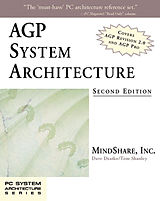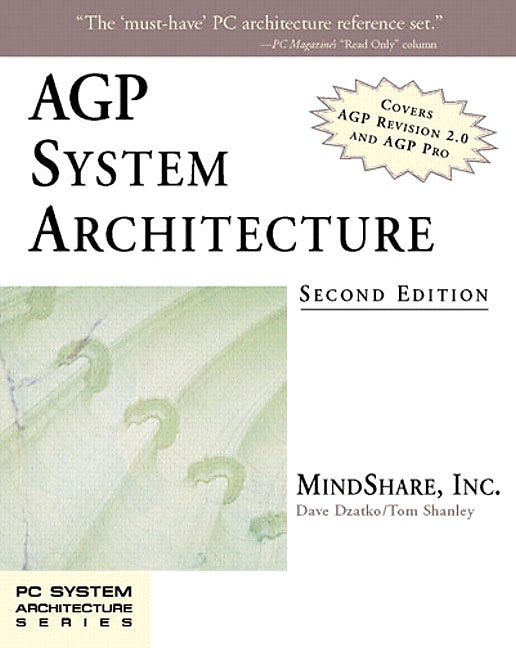AGP System Architecture
Einband:
Kartonierter Einband
EAN:
9780201700695
Untertitel:
Covers AGP Revision 2.0 and AGP Pro
Genre:
Informatik
Autor:
Inc. MindShare, Dave Dzatko, Tom Shanley
Herausgeber:
Pearson Academic
Auflage:
2. Auflage
Anzahl Seiten:
400
Erscheinungsdatum:
01.10.1999
ISBN:
978-0-201-70069-5
The Accelerated Graphics Port (AGP) interface is a platform bus specification that enables high-performance graphics capabilities, 3-D, and video--over networks as well as on individual PCs. Platform-independent, AGP is supported by numerous hardware and software vendors, and is now a standard on Intel-based platforms. Software and hardware engineers working with graphics must have a good understanding of this important technology.
AGP System Architecture, Second Edition includes all the essentials from the first edition, but has been expanded and reorganized for even better coverage. This comprehensive and concise book provides an overview of the technology, a detailed description of the specification, a discussion of AGP Pro, and a practical tutorial for mastering AGP. In particular, it focuses on 3-D graphics and video-related applications most served by AGP. It also provides a primer for the PCI bus protocol as background for a discussion on AGP and analyzes the advantages of AGP over PCI for 3-D graphics. You will find coverage of the following essential topics:
AGP dynamic memory allocation and aperture implementation
The relationship of the Microsoft® Windows OS to the AGP hardware environment
AGP subsystem enumeration and configuration using the Intel 440BX chipset as the example
AGP signaling, including North Bridge/AGP adapter interconnect examples
AGP transfer types, transaction ordering rules, and the Fence and Flush commands
AGP arbitration, including a discussion of grant pipelining optimization
AGP data transactions in the 1x, 2x, and 4x data transfer modes
FastWrite transactions
Use of turnaround cycles to prevent bus collisions during back-to-back transactions
The AGP Pro connector and card
This indispensable resource will enable you to understand AGP tools, design a high-quality AGP device, and support AGP in software applications.
The PC System Architecture Series is a crisply written and comprehensive set of guides to the most important PC hardware standards. Each title is designed to illustrate the relationship between the software and hardware, and thoroughly explains the architecture, features, and operation of systems built using the targeted technology.
0201700697B04062001
Autorentext
MindShare, Inc. is one of the leading technical training companies in the hardware industry, providing innovative courses for dozens of companies, including Intel, IBM, and Compaq.David Dzatko has over ten years of experience designing and testing computer systems. He is currently an instructor with MindShare, Inc., teaching computer architecture to leading companies in the computer industry. Tom Shanley, president of MindShare, Inc., is one of the world's foremost authorities on computer system architecture. In the course of his career, he has trained thousands of engineers in hardware and software design.
0201700697AB07142003
Inhalt
About This Book.
The MindShare Architecture Series.
Cautionary Note.
Organization of This Book.
Who This Book Is For.
Prerequisite Knowledge.
Documentation Conventions.
Visit Our Web Site.
We Want Your Feedback.
1. The 3D Graphics Challenge.
3D Graphics Compute- and Memory-Intensive.
2. PCI/AGP Adapter Overview.
System Overview.Local Versus Main Memory.PCI Graphics Adapter.Intro To AGP Graphics Adapter.
3. AGP Enumeration and Configuration.
Example Enumeration/Configuration of AGP.Host/PCI Bridge PCI Bus 0, Device 0, Function 0.AGP Enable/Disable Bit.Discovering Host/PCI Bridge's AGP Register Set.NB Connects To AGP Bus via PCI-to-PCI Bridge.PCI-to-PCI Bridge's Configuration Registers.Assigning AGP Bus Number.Device At Other End of Bus Needn't Be a Graphics Adapter.Discovering AGP Graphics Adapter.Discovering Adapter's AGP Capability Register Set.Setting Up Adapter's BAR Registers.
4. AGP Memory Allocation and Usage.
Introduction To Dynamic Memory Allocation.AGP Aperture Implementation.
5. Windows Use of AGP.
Intro to Windows Software Environment.BIOS Initialization Requirements.Operating System Initialization Requirements.
6. PCI Protocol Review.
Some Basic Rules For Both Reads and Writes.Example Single Data Phase Read.Example Burst Read.Treatment of Byte Enables During Read or Write.Performance During Read Transactions.Example Single Data Phase Write Transaction.Example Burst Write Transaction.Performance During Write Transactions.PCI Is Not An Efficient Bus.
7. Intro to AGP Concepts & Terminology.
Decoupling Address and Data Phases Optimizes Bus Usage.Bus Arbitration.Issuing Transaction Requests.PCI Bus Master Can Write to AGP Adapter's Local Memory.GART Support for PCI Masters Is Optional.Monochrome Device Adapter (MDA) Support.Some Terminology.
8. The Signal Groups.
Required Versus Optional Features.PCI Target Latency Rules Don't Apply to North Bridge.AGP Graphics Adapter Cannot Use Subtractive Decode.North Bridge/AGP Adapter Interconnect Examples.Introduction To Signal Description.AGP Clock Signal.Reset (RST#).The Signaling Environment (I/O Voltage).Where Is the AGP Bus Arbiter Located?Signal Usage In AGP Transactions.Signal Usage In PCI Transactions.Signal Usage in Fast Write Transactions.Special Overflow Prevention Signals.Unimplemented PCI Signals.Interrupt Generation.Error Reporting.USB-Related Signals.Power Management.Signal Types.Pull-Up and Pull-Down Resistor Values.
9. The Signaling Environment.
Point-to-Point Topology.Number of Devices.Signal Routing and Layout.Trace Impedance and Line Termination.Add-in Card Clock Skew Specifications.AGP Voltage Characteristics.Vref Generation.Component Pinout Recommendations.Motherboard/Add-in Card Interoperability.Pull-up/Pull-down Resistors.Maximum AC Ratings and Device Protection.Power Supply. Mechanicals.Connector Pinout.DC Specifications.1x Transfer Mode Timing Parameters.2x and 4x Transfer Mode Timing Model.Driver Characteristics.Receiver Characteristics.Changes to Clock Frequencies in Mobile Designs.
10. Intro To AGP Transfer Types.
Command Types and the Transfer Length.AGP Ordering Rules.Fence Command.Flush Command.
11. AGP Arbitration.
The AGP Arbiter.Maximizing Bus Usage via GNT# Pipelining.
12. AGP Request Transactions.
Two Request Generation Mechanisms.AGP Request Queue Depth.Issuing Transaction Requests via AD and…

Leider konnten wir für diesen Artikel keine Preise ermitteln ...
billigbuch.ch sucht jetzt für Sie die besten Angebote ...
Die aktuellen Verkaufspreise von 5 Onlineshops werden in Realtime abgefragt.
Sie können das gewünschte Produkt anschliessend direkt beim Anbieter Ihrer Wahl bestellen.
Loading...
Die aktuellen Verkaufspreise von 5 Onlineshops werden in Realtime abgefragt.
Sie können das gewünschte Produkt anschliessend direkt beim Anbieter Ihrer Wahl bestellen.
| # | Onlineshop | Preis CHF | Versand CHF | Total CHF | ||
|---|---|---|---|---|---|---|
| 1 | Seller | 0.00 | 0.00 | 0.00 |
